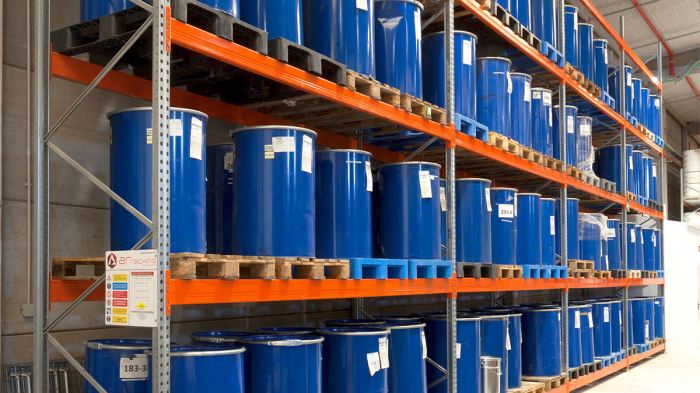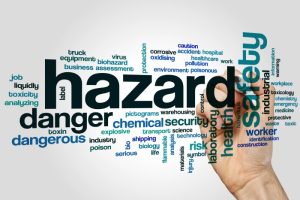
In the bustling world of industry, where chemicals are vital to countless processes, ensuring their safe storage is paramount. From manufacturing plants to research labs, the potential hazards associated with improper chemical handling are undeniable. This comprehensive guide delves into the critical aspects of chemical storage in industrial settings, exploring the legal frameworks, best practices, and essential safety measures that safeguard both workers and the environment.
The journey begins with a thorough understanding of chemical hazards, encompassing their various types, potential risks, and specific examples across different industries. We then navigate the complex landscape of regulations and standards, emphasizing the role of key agencies like OSHA and EPA in ensuring compliance. The guide then unveils a treasure trove of safe storage practices, from proper labeling and documentation to inventory management systems, all designed to minimize risks and promote order.
Personal Protective Equipment (PPE)
Wearing the right Personal Protective Equipment (PPE) when handling chemicals is essential for safeguarding your health and well-being. PPE acts as a barrier between you and hazardous chemicals, minimizing exposure and preventing potential harm.
Types of PPE and Their Uses
The specific PPE required depends on the chemical hazards involved and the tasks being performed. It’s crucial to understand the potential risks associated with each chemical and select appropriate PPE accordingly.
- Eye Protection: Safety glasses, goggles, and face shields protect your eyes from chemical splashes, fumes, and dust.
- Respiratory Protection: Respirators, such as cartridges and air-purifying respirators, safeguard your respiratory system from inhaling harmful vapors, gases, and particulate matter.
- Hand Protection: Gloves, made from various materials like nitrile, latex, or neoprene, shield your hands from chemical contact and prevent absorption through the skin.
- Skin Protection: Protective clothing, such as lab coats, coveralls, aprons, and boots, provide a barrier against chemical spills and splashes.
- Hearing Protection: Earplugs or earmuffs protect your hearing from loud noises generated by machinery or processes involving chemicals.
Examples of PPE in Different Industries
- Chemicals and Allied Products: Workers in this industry handle a wide range of chemicals, often requiring specialized PPE like chemical-resistant suits, respirators, and gloves. For example, workers handling strong acids or bases might wear acid-resistant gloves and full-body suits.
- Aerospace and Defense: In this industry, workers may encounter hazardous materials like solvents, paints, and adhesives. They typically wear respirators, gloves, and eye protection, depending on the specific chemicals and tasks involved.
- Agriculture and Forestry: Workers in these fields may use pesticides and herbicides, necessitating the use of protective clothing, respirators, and gloves to minimize exposure. For instance, agricultural workers applying pesticides often wear coveralls, respirators, and gloves to prevent skin and respiratory contact.
Emergency Response and Spill Management

A comprehensive emergency response plan is crucial for ensuring the safety of personnel and the environment in industrial settings. It Artikels the procedures for responding to chemical emergencies, including spills and leaks, minimizing their impact, and ensuring the well-being of everyone involved.
Emergency Response Plan
A well-developed emergency response plan serves as a vital tool for effectively managing chemical emergencies. It provides a framework for coordinating actions, assigning responsibilities, and ensuring a swift and organized response.
- Identify potential hazards: Conduct a thorough assessment of all chemicals stored and used on-site, identifying potential hazards associated with each substance. This includes understanding their flammability, toxicity, reactivity, and other relevant properties.
- Establish clear communication channels: Define a chain of command and establish clear communication channels for reporting emergencies. This may involve using alarms, sirens, or designated emergency contacts.
- Train personnel: Provide comprehensive training to all employees on the proper procedures for responding to chemical emergencies. This should include first aid, evacuation procedures, spill control techniques, and the use of personal protective equipment.
- Develop evacuation procedures: Artikel clear evacuation procedures for different scenarios, including the designated assembly points and emergency exits. This should also include plans for the safe evacuation of people with disabilities.
- Maintain emergency equipment: Ensure that all emergency equipment, such as spill kits, fire extinguishers, and personal protective equipment, is readily available, in good working condition, and properly maintained.
- Conduct regular drills: Conduct regular drills to test the emergency response plan and ensure that all personnel are familiar with their roles and responsibilities. This helps to identify any weaknesses and improve the effectiveness of the plan.
Spill Management
Chemical spills and leaks pose significant risks to human health and the environment. Effective spill management practices are essential for mitigating these risks and preventing further harm.
- Contain the spill: The first step in managing a spill is to contain it. This may involve using absorbent materials, dikes, or other barriers to prevent the spread of the chemical.
- Isolate the area: Isolate the spill area to prevent unauthorized access and protect personnel from exposure to the chemical. This may involve cordoning off the area with warning signs and barriers.
- Evacuate personnel: Evacuate all personnel from the spill area and any potentially affected areas. Ensure that everyone is safe and accounted for.
- Personal protective equipment: Wear appropriate personal protective equipment, such as respirators, gloves, and protective clothing, to prevent contact with the chemical.
- Control the source: If possible, identify and control the source of the spill. This may involve shutting off valves, pumps, or other equipment.
- Neutralize or absorb the chemical: Depending on the chemical involved, use appropriate methods to neutralize or absorb the spill. This may involve using specialized chemicals, absorbent materials, or other techniques.
- Dispose of the spill: Properly dispose of the spilled chemical and any contaminated materials in accordance with local regulations and environmental guidelines.
Flowchart for Chemical Emergency Response
A flowchart provides a visual representation of the procedures for responding to chemical emergencies in different industrial settings. It helps to streamline the response process, ensuring that all necessary steps are taken in a timely and efficient manner.
- Detection of Emergency: This could be triggered by an alarm, a visual observation, or a report from a worker.
- Assessment of the Situation: Identify the type of chemical involved, the extent of the spill or leak, and any potential hazards.
- Activate Emergency Response Plan: Initiate the pre-defined plan, including the activation of alarms, notification of emergency services, and the mobilization of trained personnel.
- Isolate and Evacuate: Isolate the affected area and evacuate personnel, following the established procedures.
- Control the Spill: Implement appropriate containment measures to prevent further spread of the chemical.
- Clean-up and Disposal: Neutralize or absorb the chemical and dispose of the contaminated materials safely and in accordance with regulations.
- Post-Incident Review: Conduct a thorough review of the incident to identify areas for improvement and to update the emergency response plan.
Training and Awareness

A comprehensive chemical safety training program is essential for ensuring a safe working environment in industrial settings. Regular training helps employees understand the hazards associated with chemicals, learn proper handling procedures, and develop the skills necessary to respond effectively to emergencies.
Importance of Regular Safety Training
Regular training programs are crucial for maintaining a high level of safety awareness among employees. They help to:
- Reduce accidents and incidents: By equipping employees with the knowledge and skills to handle chemicals safely, training programs can significantly reduce the risk of accidents and incidents. This leads to a safer workplace, fewer injuries, and reduced costs associated with accidents.
- Improve compliance with regulations: Many industries are subject to strict regulations regarding the handling and storage of chemicals. Training programs ensure that employees are aware of these regulations and understand their responsibilities for compliance.
- Enhance employee knowledge and skills: Regular training keeps employees up-to-date on best practices, new technologies, and evolving safety standards. This helps them stay informed and adapt to changing workplace conditions.
- Promote a culture of safety: When employees receive consistent safety training, it reinforces the importance of safety in the workplace. This contributes to a positive safety culture where everyone feels responsible for their own safety and the safety of their colleagues.
Key Topics in Chemical Safety Training Programs
Chemical safety training programs should cover a wide range of topics, including:
- Chemical hazard identification and assessment: Employees should be able to identify and assess the hazards associated with different chemicals. This includes understanding the physical and health hazards, such as flammability, corrosivity, toxicity, and reactivity.
- Personal Protective Equipment (PPE): Training should cover the selection, use, and maintenance of appropriate PPE for handling chemicals. This includes gloves, respirators, eye protection, and protective clothing.
- Safe handling and storage practices: Employees should be trained on proper procedures for handling, transferring, and storing chemicals. This includes techniques for opening containers, dispensing chemicals, and preventing spills.
- Emergency response procedures: Training should cover emergency response procedures in the event of a chemical spill or release. This includes knowing how to evacuate the area, use emergency equipment, and contact emergency services.
- Waste management and disposal: Employees should be trained on proper procedures for handling, storing, and disposing of chemical waste. This includes understanding the regulations and procedures for managing hazardous waste.
- Chemical labeling and documentation: Employees should be familiar with the information provided on chemical labels and safety data sheets (SDSs). They should be able to interpret this information and understand the risks associated with the chemicals.
- Communication and reporting: Training should cover procedures for communicating chemical hazards and incidents. This includes reporting spills, accidents, and near misses to supervisors and safety personnel.
Training Materials and Resources
There are various training materials and resources available to support chemical safety training programs. These include:
- Online courses and modules: Many organizations offer online courses and modules on chemical safety, covering a wide range of topics. These courses can be accessed at any time and offer flexibility for employees.
- Interactive simulations and games: Interactive simulations and games can provide engaging and memorable learning experiences for employees. These tools can help to reinforce key concepts and make training more enjoyable.
- Industry-specific resources: Several industry organizations provide specific training materials and resources for their members. For example, the American Chemistry Council (ACC) offers resources for the chemical industry, while the National Safety Council (NSC) provides resources for various industries.
- Government agencies: Government agencies, such as the Occupational Safety and Health Administration (OSHA) and the Environmental Protection Agency (EPA), provide guidance and resources on chemical safety. These resources can help organizations develop effective training programs and ensure compliance with regulations.
Chemical Storage Best Practices by Industry
Safe and effective chemical storage is crucial across various industries, and the specific challenges and best practices vary depending on the nature of the chemicals handled and the industry’s unique requirements. Understanding these nuances is essential for ensuring the safety of workers, the environment, and the community.
Chemical and Allied Products Industry
This industry faces a wide range of challenges in storing chemicals due to the diverse nature of products manufactured. The chemicals handled include raw materials, intermediates, and finished products, each with its unique properties and hazards.
- Challenges:
- Storage of highly reactive, flammable, and corrosive chemicals requires specialized handling and containment systems.
- Large-scale storage necessitates efficient inventory management and tracking to prevent obsolescence and potential hazards.
- Compliance with stringent regulations regarding labeling, packaging, and transportation of hazardous materials is crucial.
- Best Practices:
- Segregation of incompatible chemicals in dedicated storage areas with appropriate barriers and ventilation systems.
- Implementation of robust inventory management systems to track stock levels, expiration dates, and material safety data sheets (MSDS).
- Regular inspections and maintenance of storage facilities, including leak detection and containment systems.
Aerospace and Defense Industry
The aerospace and defense industry utilizes a wide range of specialized chemicals, including fuels, propellants, and cleaning agents, presenting unique storage challenges.
- Challenges:
- Storage of volatile and flammable materials like jet fuels and rocket propellants requires strict safety measures and specialized storage tanks.
- The use of highly reactive chemicals in manufacturing processes demands secure storage and handling protocols to prevent accidental ignition or explosions.
- Compliance with military and aviation regulations regarding chemical storage and transportation is paramount.
- Best Practices:
- Designated storage areas for different classes of chemicals with fire suppression systems and appropriate ventilation.
- Regular inspections and maintenance of storage tanks and piping systems to ensure leak-proof operations.
- Implementation of strict access control and security measures to prevent unauthorized access to hazardous materials.
Agriculture and Forestry Industry
This industry relies heavily on pesticides, herbicides, and fertilizers, presenting unique challenges in chemical storage due to their potential impact on the environment and human health.
- Challenges:
- Storage of agricultural chemicals in open fields or near water bodies poses risks of contamination and runoff.
- Ensuring proper labeling and handling to prevent accidental misuse or spills is crucial.
- Compliance with environmental regulations and best practices for pesticide and fertilizer application is essential.
- Best Practices:
- Storage of chemicals in secure, well-ventilated, and weather-proof facilities away from water sources and sensitive areas.
- Use of spill containment systems and absorbent materials to mitigate accidental releases.
- Implementation of training programs for workers on safe handling, application, and disposal of agricultural chemicals.
Storing chemicals safely in industrial settings is not merely a matter of compliance; it’s a commitment to a culture of safety. By embracing best practices, implementing robust emergency response plans, and fostering a culture of continuous learning, we can create a safer work environment for all. This guide serves as a beacon, illuminating the path toward responsible chemical management and ensuring a future where industry thrives alongside environmental and worker safety.
Query Resolution
What are some common chemical hazards found in industrial settings?
Common chemical hazards include flammable liquids, corrosive substances, toxic materials, and reactive chemicals. The specific hazards vary depending on the industry and the chemicals used.
What are the most important regulations for chemical storage?
Key regulations include the Occupational Safety and Health Administration (OSHA) Hazard Communication Standard (HazCom), the Environmental Protection Agency (EPA) regulations on hazardous waste, and the National Fire Protection Association (NFPA) standards for chemical storage.
How often should chemical storage facilities be inspected?
Regular inspections should be conducted at least annually, or more frequently if there are changes in chemical inventory or storage practices.
What are some examples of personal protective equipment (PPE) used in chemical handling?
Examples of PPE include gloves, respirators, safety goggles, and protective clothing, with the specific type depending on the chemical hazards involved.





